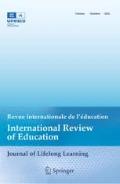Abstract
The educational system in major parts of Africa, where post-primary enrolment rates are the lowest in the world, is treated in this article. In particular, female access patterns to formal education in Botswana, Liberia, Niger and Somalia are compared. One primary conclusion reached by the authors is that enrolment levels are linked with general economic development. Factors leading to the comparatively high rate of females having gained access to a primary level of education on the one hand, and a very low rate of post-primary enrolment on the other, are discussed and the following issues are touched on: the marginal link between school expansion policies and actual female enrolment, and their predominance in the urban sector.
Zusammenfassung
In diesem Artikel wird das Erziehungssystem in großen Teilen Afrikas besprochen, wo die postprimare Einschulungsraten die niedrigsten der Welt sind. Insbesondere wird der Anteil von Mädchen und Frauen in formalen Bildungsstätten in Botswana, Liberia, Niger und Somalia verglichen. Die Zwischenbilanz der Verfasser zeigt, daß die Einschulungsraten an die allgemeine wirtschaftliche Entwicklung gekoppelt sind. Die Faktoren, die zu einer vergleichsweise hohen Anzahl von Mädchen und Frauen auf der Primarstufe der Bildungsstätte auf der einen Seite und einem sehr niedrigen Anteil im postprimaren Bereich auf der anderen Seite führen, werden diskutiert. In diesem Zusammenhang werden die folgenden Fragen gestreift: Die marginale Verbindung von der Expansionspolitik der Schulen und dem derzeitigen Anteil von Mädchen und Frauen in Bildungsstätten sowie deren Überwiegen im urbanen Bereich.
Résumé
Dans le cadre d'une analyse empirique des structures d'accès des femmes à l'éducation formelle en Afrique, on compare les développements et les tendances dans différents pays tels le Botswana, le Liberia, le Niger et la Somalie. Les auteurs soulignent, en guise de conclusion essentielle, que les effectifs sont liés au développement économique général. L'accès des femmes à l'éducation dépend également de l'expansion du système d'éducation dans son ensemble. On analyse les facteurs permettant un taux relativement élevé de femmes ayant eu accès à l'enseignement primaire d'une part, et le taux très bas des effectifs post-primaires d'autre part. Les problèmes suivants sont soulevés: le lien marginal entre les politiques d'expansion scolaire et les effectifs actuels des femmes, et leur prédominance dans le secteur urbain.
Similar content being viewed by others
References
Cochrane, S.R.Fertility and Education: What Do We Really Know? Baltimore: Johns Hopkins University Press, 1979.
Cochrane, S.H.The Socio-Economic Determinants of Mortality: The Cross-National Evidence. Washington, DC: World Bank, 1980.
Inkeles, A. and Smith, D.H.Becoming Modern: Individual Change in Six Developing Countries. Cambridge, Mass.: Harvard University Press, 1974.
Levine, R.A. ‘Influence of Women's Schooling on Maternal Behavior in the Third World’.Comparative Education Review. 24 (1980), No. 2, pp. 78–105.
Mingat, A. and Psacharopoulos, G. ‘Financing Education in Sub-Saharan Africa’.Finance and Development. 22 (1985), No. 1.
Ram, R. ‘Sex Differences in the Labor Market Outcomes of Education’.Comparative Education Review. 24 (1980), No. 2, pp. 53–77.
Unesco.Trends and Projections of Enrollment by Level of Education and by Age: 1960–2000 (as Assessed in 1982). Paris: Office of Statistics, 1983.
Windham, D.M.Internal Efficiency and the African School (unpublished manuscript). Albany, NY: Department of Education, State University of New York, 1985. (Available from IEES Clearinghouse, 204 Dodd Hall, Learning Systems Institute, Florida State University).
World Bank.World Bank Report 1983. Washington, DC: World Bank, 1983.
Rights and permissions
About this article
Cite this article
Adams, M.N., Kruppenbach, S.E. Gender and access in the African school. Int Rev Educ 33, 437–453 (1987). https://doi.org/10.1007/BF00615158
Issue Date:
DOI: https://doi.org/10.1007/BF00615158




